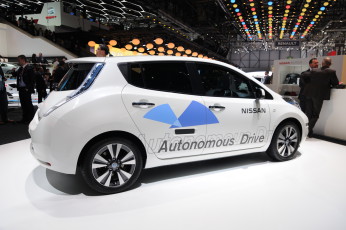 By: Peyton Stroud, Associate Notes and Comments Editor
By: Peyton Stroud, Associate Notes and Comments Editor
Are we there yet? The common adage of road trips has a whole new meaning with the advent of driverless cars. Imagine a world where the front seat driver can face the backseat passengers, with the car driving itself down the highway. As of this past January, this dream is becoming a reality. Automotive giants such as BMW, Audi, and Mercedes-Benz unveiled prototypes of self-driving technologies in the recent 2015 Consumer Electronics Show (CES).[1] These new vehicle models function autonomously while allowing its passengers to sit back and relax. Industry experts expect these driverless vehicles to be on the road between 2017 and 2020.[2]
Many current models of cars are already featuring some self-driving technologies including automatic braking systems, adjustable cruise controls, and 360° cameras capable of stopping collisions while at low speeds.[3] However, this year’s CESs brought more to the table than ever before. During this year’s CES, Audi unveiled its self-driving car, nicknamed “Jack,” using its system known as the company’s Piloted Driving system.[4] “Jack” drove an astounding 560 miles to the CES, more than any driverless car has driven before. Its state of the art system incorporates a series of sensors and laser scanners allowing the car to drive itself in speeds of up to 70 mph.[5] The Piloted Driving system is intended to be used for highway driving and does not work as well in urban environments, where drivers need to be at the wheel.[6] Similarly, Mercedes-Benz introduced its driverless model called the Mercedes-Benz F105 Luxury in Motion.[7] Its new features include a self-driving technology and a zero carbon emissions system, but most notably a new interior design.[8] The new design allows for the vehicle’s front seats to swing around and face backwards while the vehicle drives its passengers on the highway.[9]
Other technology developers are joining forces with car manufactures to help advance this technology.[10] Nvidia, a large computer chip manufacturer, has introduced the Tegra X1 chip equipping vehicles with deep neural learning, which allows for recognition of pedestrians, cyclists, and other vehicles. More technological innovations on the horizon include systems setting a predetermined route, more adjustable cruise controls, and self-parking technologies.[11]
Legally, self-driving smart cars could pose some significant problems in both the regulatory and data privacy realm.[12] In a regulatory sense, there are currently no transportation laws regarding self-driving cars.[13] Furthermore, others remain weary of the “data collection” required by the cars. [14] However, the most profound legal implication could be liability ridden – Who is responsible when something goes wrong? More specifically, who is liable if a self-driving cars hits and kills someone? Who is responsible for the parking ticket when the car did not recognize a no parking sign?[15] Only four states and the District of Columbia have addressed laws regarding self-driving vehicles.[16] Some of these states have passed laws allowing manufacturers solely for testing purposes.[17] In an effort to predict the legal implications of these new cars, lawyers look to current liability laws for guidance.[18] For example, in cases of parking tickets, the owners of the car will be liable.[19] In cases of injury, product’s liability law will most likely govern cases of injury thereby allowing the victim to sue both the owner of the car and also the car’s manufacturer. According to Professor John Villasenor, “product liability law, which holds manufacturers responsible for faulty products, tends to adapt well to new technologies.”[20] Furthermore, Sebastian Thrun, inventor of driverless cars, opines that these driverless cars could help in reconstructing accidents and making assignment of blame more clear-cut.[21] In his view, the trial lawyers are the ones in trouble.[22]
However, criminal penalties pose a more significant problem than civil penalties.[23] Since criminal law centers around the intent of the perpetrator, it will be difficult to figure out how to adapt these laws to technology because robots cannot be charged with a crime.[24] Further, “the fear of robots” and of a machine malfunctioning raise concerns for the American public.[25] However, it seems as if Americans are willing to take the risk. According to the Pew Research Center, nearly half of Americans would ride in a driver-less car.[26] Time will tell if these self-driving cars will endure public scrutiny.
[1] See Steve Brachmann, Self-driving Cars and Other Automotive Technologies Take Center Stage at CES, IPWatchdog.com (Jan. 11, 2015), http://www.ipwatchdog.com/2015/01/11/self-driving-cars-center-stage-at-ces/id=53480/.
[2] Bill Howard, Self-driving Cars Are More Than A Promise, Extreme Tech (Jan. 12, 2015, 11:45 AM), http://www.extremetech.com/extreme/197262-its-2015-self-driving-cars-are-more-than-a-promise.
[3] Brachmann, supra note 1.
[4] Id.
[5] Brachmann, supra note 1.
[6] Id.
[7] Id.
[8] Id.
[9] Id.
[10] See Howard, supra note 3.
[11] See id.
[12] See id.
[13] See id.
[14] Id.
[15] See Claire Cann Miller, When Driverless Cars Break the Law, N.Y. Times (May 13, 2014), available at http://www.nytimes.com/2014/05/14/upshot/when-driverless-cars-break-the-law.html?_r=0&abt=0002&abg=0.
[16] See id.
[17] See id.
[18] See id.
[19] See id.
[20] Miller, supra note 11 (quoting John Villasensor, Products Liability and Driverless Cars: Issues and Guiding Principles for Legislation, Brookings (Apr. 2014), available at http://www.brookings.edu/~/media/research/files/papers/2014/04/products%20liability%20driverless%20cars%20villasenor/products_liability_and_driverless_cars.pdf).
[21] See Miller, supra note 11.
[22] See id.
[23] Id.
[24] See id.
[25] Miller, supra note 11.
[26] See id.
